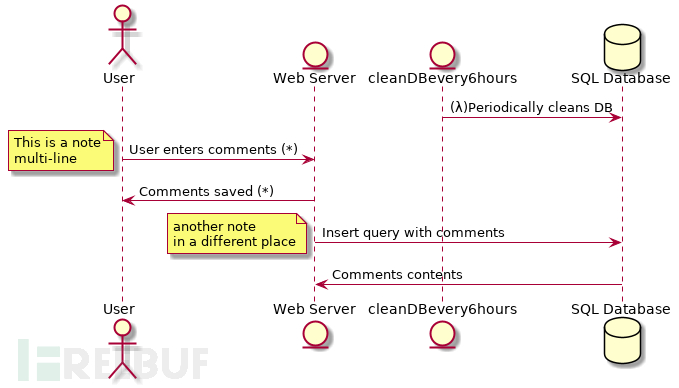

Pytm是一款Python风格的威胁建模框架,它可以帮助我们以Python语言风格的形式并使用pytm框架中的元素和属性来定义你的系统。根据我们的定义参数,pytm可以针对你的系统生成数据流图(DFD)、序列图以及威胁模型。
工具要求
Linux/MacOS
Python 3.x
Graphviz package
Java (OpenJDK 10 or 11)
工具下载
广大研究人员可以使用下列命令将该项目源码克隆至本地:
git clone https://github.com/izar/pytm.git工具使用
tm.py [-h] [--debug] [--dfd] [--report REPORT] [--exclude EXCLUDE] [--seq] [--list] [--describe DESCRIBE]
optional arguments:
-h, --help show this help message and exit
--debug print debug messages
--dfd output DFD (default)
--report REPORT output report using the named template file (sample template file is under docs/template.md)
--exclude EXCLUDE specify threat IDs to be ignored
--seq output sequential diagram
--list list all available threats
--describe DESCRIBE describe the properties available for a given element
当前该工具可用的元素包括:TM、服务器、外部实体、数据存储、Actor、进程、进程集、数据边界和Lambda。
除此之外,我们也可以使用命令“–describe”来查看每一个元素的可用属性:
(pytm) ➜ pytm git:(master) ✗ ./tm.py --describe Element
Element
OS
check
definesConnectionTimeout
description
dfd
handlesResources
implementsAuthenticationScheme
implementsNonce
inBoundary
inScope
isAdmin
isHardened
name
onAWS
如果你是安全从业人员的话,你也可以向“threatlib/threats.json”文件中添加新的威胁属性:
{
"SID":"INP01",
"target": ["Lambda","Process"],
"description": "Buffer Overflow via Environment Variables",
"details": "This attack pattern involves causing a buffer overflow through manipulation of environment variables. Once the attacker finds that they can modify an environment variable, they may try to overflow associated buffers. This attack leverages implicit trust often placed in environment variables.",
"Likelihood Of Attack": "High",
"severity": "High",
"condition": "target.usesEnvironmentVariables is True and target.sanitizesInput is False and target.checksInputBounds is False",
"prerequisites": "The application uses environment variables.An environment variable exposed to the user is vulnerable to a buffer overflow.The vulnerable environment variable uses untrusted data.Tainted data used in the environment variables is not properly validated. For instance boundary checking is not done before copying the input data to a buffer.",
"mitigations": "Do not expose environment variable to the user.Do not use untrusted data in your environment variables. Use a language or compiler that performs automatic bounds checking. There are tools such as Sharefuzz [R.10.3] which is an environment variable fuzzer for Unix that support loading a shared library. You can use Sharefuzz to determine if you are exposing an environment variable vulnerable to buffer overflow.",
"example": "Attack Example: Buffer Overflow in $HOME A buffer overflow in sccw allows local users to gain root access via the $HOME environmental variable. Attack Example: Buffer Overflow in TERM A buffer overflow in the rlogin program involves its consumption of the TERM environmental variable.",
"references": "https://capec.mitre.org/data/definitions/10.html, CVE-1999-0906, CVE-1999-0046, http://cwe.mitre.org/data/definitions/120.html, http://cwe.mitre.org/data/definitions/119.html, http://cwe.mitre.org/data/definitions/680.html"
}
注意事项
“threats.json”文件中包含的字符串可以通过eval()函数来运行,它可以确保文件拥有正确的权限并确保代码能够正确执行。
下面的样本是tm.py文件,它描述了一个简单的应用程序,其中一名用户“User”登录进了应用程序,然后在App上发布了评论。App服务器将这些评论存储进了数据库,服务器中有一个AWS Lambda会定期清理数据库。
#!/usr/bin/env python3
from pytm.pytm import TM, Server, Datastore, Dataflow, Boundary, Actor, Lambda
tm = TM("my test tm")
tm.description = "another test tm"
User_Web = Boundary("User/Web")
Web_DB = Boundary("Web/DB")
user = Actor("User")
user.inBoundary = User_Web
web = Server("Web Server")
web.OS = "CloudOS"
web.isHardened = True
db = Datastore("SQL Database (*)")
db.OS = "CentOS"
db.isHardened = False
db.inBoundary = Web_DB
db.isSql = True
db.inScope = False
my_lambda = Lambda("cleanDBevery6hours")
my_lambda.hasAccessControl = True
my_lambda.inBoundary = Web_DB
my_lambda_to_db = Dataflow(my_lambda, db, "(λ)Periodically cleans DB")
my_lambda_to_db.protocol = "SQL"
my_lambda_to_db.dstPort = 3306
user_to_web = Dataflow(user, web, "User enters comments (*)")
user_to_web.protocol = "HTTP"
user_to_web.dstPort = 80
user_to_web.data = 'Comments in HTML or Markdown'
user_to_web.order = 1
web_to_user = Dataflow(web, user, "Comments saved (*)")
web_to_user.protocol = "HTTP"
web_to_user.data = 'Ack of saving or error message, in JSON'
web_to_user.order = 2
web_to_db = Dataflow(web, db, "Insert query with comments")
web_to_db.protocol = "MySQL"
web_to_db.dstPort = 3306
web_to_db.data = 'MySQL insert statement, all literals'
web_to_db.order = 3
db_to_web = Dataflow(db, web, "Comments contents")
db_to_web.protocol = "MySQL"
db_to_web.data = 'Results of insert op'
db_to_web.order = 4
tm.process()
图表将以Dot或PlantUML的形式输出。
如果在运行tm.py文件时使用了“--dfd”参数,那么它将会向stdout生成输出文件:
tm.py --dfd | dot -Tpng -o sample.png生成的图表如下:

下列命令可以生成一份序列图:
tm.py --seq | java -Djava.awt.headless=true -jar plantuml.jar -tpng -pipe > seq.png
生成的图表和数据可以引入到模板文件中来创建最终的报告:
tm.py --report docs/template.md | pandoc -f markdown -t html > report.html用于生成报告的模板格式如下:
# Threat Model Sample
***
## System Description
{tm.description}
## Dataflow Diagram

## Dataflows
Name|From|To |Data|Protocol|Port
----|----|---|----|--------|----
{dataflows:repeat:{{item.name}}|{{item.source.name}}|{{item.sink.name}}|{{item.data}}|{{item.protocol}}|{{item.dstPort}}
}
## Findings
{findings:repeat:* {{item.description}} on element "{{item.target}}"
}
当前支持的威胁如下:
INP01 - Buffer Overflow via Environment Variables
INP02 - Overflow Buffers
INP03 - Server Side Include (SSI) Injection
CR01 - Session Sidejacking
INP04 - HTTP Request Splitting
CR02 - Cross Site Tracing
INP05 - Command Line Execution through SQL Injection
INP06 - SQL Injection through SOAP Parameter Tampering
SC01 - JSON Hijacking (aka JavaScript Hijacking)
LB01 - API Manipulation
AA01 - Authentication Abuse/ByPass
DS01 - Excavation
DE01 - Interception
DE02 - Double Encoding
API01 - Exploit Test APIs
AC01 - Privilege Abuse
INP07 - Buffer Manipulation
AC02 - Shared Data Manipulation
DO01 - Flooding
HA01 - Path Traversal
AC03 - Subverting Environment Variable Values
DO02 - Excessive Allocation
DS02 - Try All Common Switches
INP08 - Format String Injection
INP09 - LDAP Injection
INP10 - Parameter Injection
INP11 - Relative Path Traversal
INP12 - Client-side Injection-induced Buffer Overflow
AC04 - XML Schema Poisoning
DO03 - XML Ping of the Death
AC05 - Content Spoofing
INP13 - Command Delimiters
INP14 - Input Data Manipulation
DE03 - Sniffing Attacks
CR03 - Dictionary-based Password Attack
API02 - Exploit Script-Based APIs
HA02 - White Box Reverse Engineering
DS03 - Footprinting
AC06 - Using Malicious Files
HA03 - Web Application Fingerprinting
SC02 - XSS Targeting Non-Script Elements
AC07 - Exploiting Incorrectly Configured Access Control Security Levels
INP15 - IMAP/SMTP Command Injection
HA04 - Reverse Engineering
SC03 - Embedding Scripts within Scripts
INP16 - PHP Remote File Inclusion
AA02 - Principal Spoof
CR04 - Session Credential Falsification through Forging
DO04 - XML Entity Expansion
DS04 - XSS Targeting Error Pages
SC04 - XSS Using Alternate Syntax
CR05 - Encryption Brute Forcing
AC08 - Manipulate Registry Information
DS05 - Lifting Sensitive Data Embedded in Cache
项目地址
Pytm:【GitHub传送门】
*参考来源:izar,FB小编Alpha_h4ck编译,转载请注明来自FreeBuf.COM
如有侵权请联系:admin#unsafe.sh